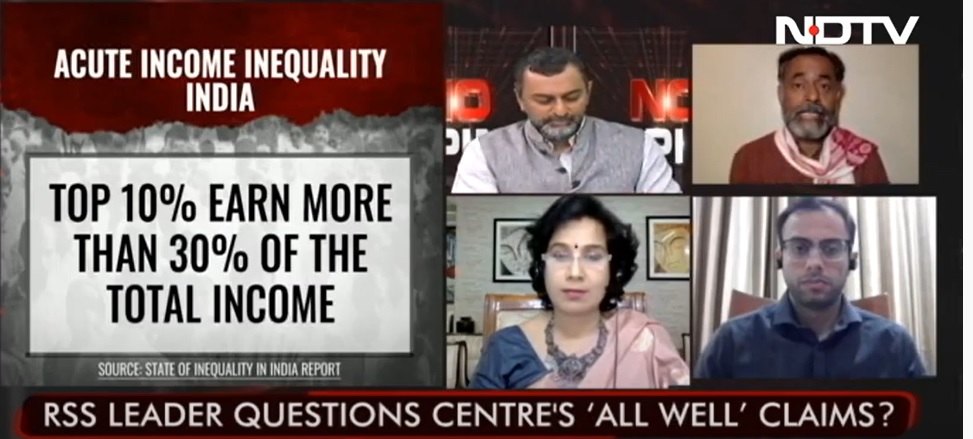 'Why Has Truth Suddenly Dawned Upon RSS': Yogendra Yadav On RSS criticism Over Inequality | No Spin https://www.youtube.com/watch?v=vIWSeqapYV0
'Why Has Truth Suddenly Dawned Upon RSS': Yogendra Yadav On RSS criticism Over Inequality | No Spin https://www.youtube.com/watch?v=vIWSeqapYV0
Oct 4, 2022 Swaraj India member Yogendra Yadav questioned why the RSS has suddenly woken up on India’s inequality, a day after an RSS leader’s criticism over the state of economy and jobs. Mr Yadav said the RSS has been compelled to speak up since all data being discussed on income inequality is in the public domain now. Full programme: https://www.youtube.com/watch?v=M0fMNCg9yVI
Poverty, unemployment are demons in today’s world: RSS https://www.thehindu.com/news/national/poverty-unemployment-are-demons-in-todays-world-rss/article65963438.ece
Ishita Mishra OCTOBER 02, 2022 even after India managed to grow to a great extent economically, economic inequality is a matter of concern.
RSS-backed Swadeshi Jagran Manch to launch pan-India self-reliance campaign https://www.hindustantimes.com/india-news/rss-backed-swadesh-jagran-manch-to-launch-pan-india-self-reliance-campaign/story-0Xw5EaBsrF5eEMWNNToqrM.html
May 19, 2020 02:34 PM IST
Ashwani Mahajan, the national co convenor of the SJM self-reliance means ‘swadeshi’ only; and it can be achieved by rejuvenating indigenous industry, including small scale industries, small businesses, artisans, rural industries, including food processing industry, and other non-farm activities. A comprehensive plan is being drawn that will involve workers, farmers, small scale entrepreneurs, academicians, technocrats, industry and trade leaders to create awareness about the benefits of promoting swadeshi or local products
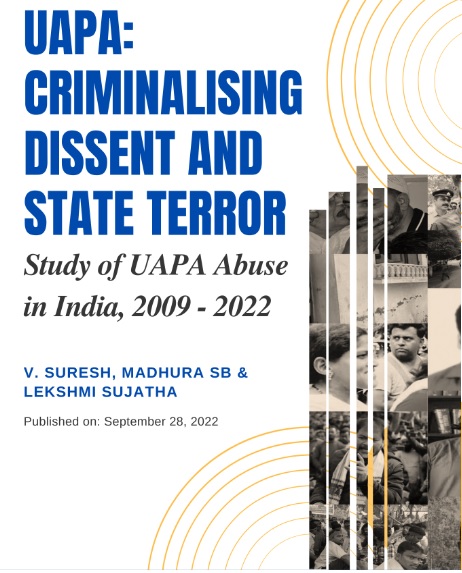 Analysis of the data so collected and segregated would help expose if Sec. 18 was used deliberately only for the purpose of implicating persons under UAPA to ensure that they did not get bail easily.
Analysis of the data so collected and segregated would help expose if Sec. 18 was used deliberately only for the purpose of implicating persons under UAPA to ensure that they did not get bail easily.
What is significant is that 152/238 cases (or 64%) cases involving Sec. 18 charge are in
respect of cases where there is no allegation of a terrorist act or an actual incident of terror
involving the use of weapons or causing physical injury is reported to have taken place. In other
words, in more than half (64%) of the UAPA cases involving Sec.18 charge, the mere allegation
of the police that a person is a member of a proscribed terrorist organisation or that a recovery
of weapon/explosives/money/drugs were made from him is sufficient to get the person arrested
and imprisoned for many years.
Those arrested under UAPA languish in jail sometimes even for decades, waiting for their
trial to begin. By the time they are acquitted, the damage is complete; an irreparable damage is
done to several aspects of their lives, inflicting pain and trauma on them and on all those
dependent on them...
By beginning to document the scale of abuse faced by thousands
under this law and by formulating a comprehensive database on all UAPA prosecutions across
the country, the dangers in the ambiguities of the UAPA law and its draconian provisions
become all the more striking. The objective is also to stimulate more discussions and encourage
more research on the constitutional, moral, ethical and human consequences of the UAPA and
the NIA, as we all come together and demand the repeal of the law.
We ask of the civil societies to be more vigilant, to come together and raise their voices
against the flagrant state abuse. We urge the political parties and leaders of the entire political
spectrum to aid in strengthening the demand to repeal the draconian UAPA and other such laws
which should not have a place in a constitutional democracy where rule of law is upheld
We
seek your support through the following actions:
1. Demand repeal of UAPA.
2. Demand repeal of all other anti-people laws.
3. Demand repeal of the NIA Act and disbanding of NIA.
4. Demand the immediate release of all political prisoners, on bail.
5. Take action against all police officials who have wilfully launched false and
fabricated cases against the marginalised communities, journalists, academicians,
students and others.
6. Take action to provide reparations for those wrongfully accused and released by
courts.
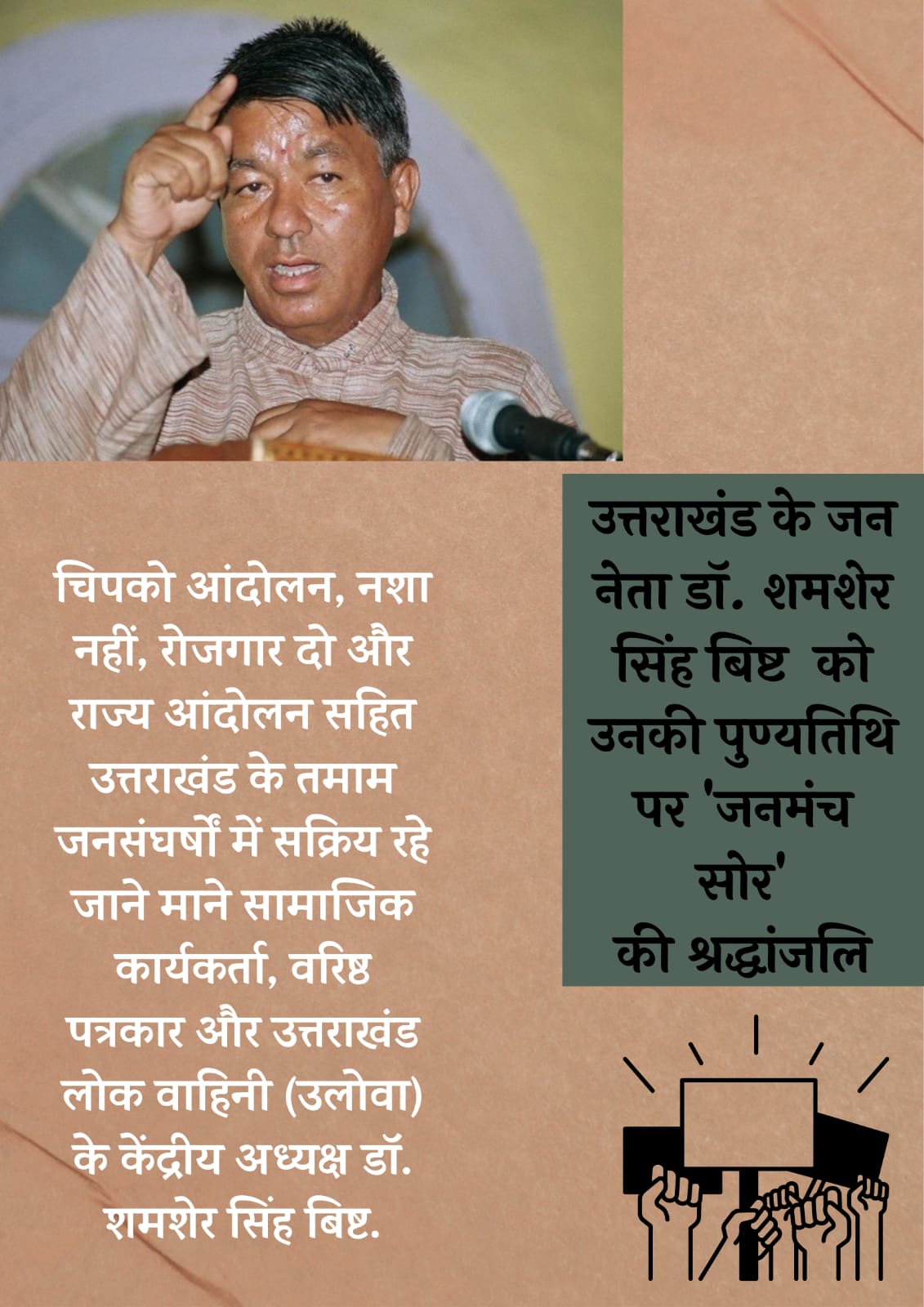 A legend of Uttarakhand Dr. Shamsher Singh Bisht is no more. https://www.newsviewsnetwork.com/a-legend-of-uttarakhand-dr-shamsher-singh-bisht-is-no-more-dies-at-73/ INDIAA legend of Uttarakhand Dr. Shamsher Singh Bisht is no more.
A legend of Uttarakhand Dr. Shamsher Singh Bisht is no more. https://www.newsviewsnetwork.com/a-legend-of-uttarakhand-dr-shamsher-singh-bisht-is-no-more-dies-at-73/ INDIAA legend of Uttarakhand Dr. Shamsher Singh Bisht is no more.
The land of abode of Gods Uttarakhand has today lost a relentless fighter, journalist, author, an ideologue, a social reformer, a committed activist, prominent Uttrakhand separate state activist n leader and the former student and youth leader with progressive ideals and principles.
He was an active participant and a youth pioneer in various movements such as Chipko, Nasha Nahi Rojgaar Do, movements for environmental protection and for the conservation of forests, water and land in Uttarakhand. Dr. Shamsher Singh Bisht regularly wrote on the soci economic, cultural, environmental and societal issues of Uttarakhand in the leading state dailies n other vernacular periodicals like Jan Satta, Amar Ujala, Dainik Jagran, Nav Bharat Times, etc.
शमशेर सिंह बिष्ट https://www.nainitalsamachar.org/shamsher-singh-bisht/
शमशेर सिंह बिष्ट के जन्मदिन पर विशेष : सुनो उस राजा की कहानी | पास ना जिसके घोड़ा पालकी ना थी राजधानी
Corporatising Agriculture and Foreign Investors -Farmer-owned Sahyadri Farms has raised Rs 310 crore from a group of European investors By Jayashree Bhosale Sep 14, 2022, https://economictimes.indiatimes.com/news/company/corporate-trends/farmer-owned-sahyadri-farms-has-raised-rs-310-crore-from-a-group-of-european-investors/articleshow/94202814.cms Foreign investment story of Sahyadri FPO is now become the discussion points amongst all of us mainly in the development and FPO sector.
Bharat Jodo Yatra has opened room for new imagination of India — ‘South-up’ Yogendra Yadav 14 September, 2022 https://theprint.in/opinion/bharat-jodo-yatra-has-opened-room-for-new-imagination-of-india-south-up/1127886/ If we have to resist majoritarianism, we must turn to the three ideological pillars of Dravidian politics: Regionalism, rationalism, and social justice in new ways.
Professor G. N. Devy has a name for this imagination: Dakshinayan. It is the name of the movement he started with many other writers in 2016. We were lucky that he had also come for the inauguration of the yatra and was there with us at the breakfast table that morning. Over idli sambhar and a good cup of my favourite South Indian filter coffee, he explained to us the concept and the story of Dakshinayan. You must hear from him the story of how his wife Surekha and he shifted their home from Vadodara in Gujarat to Dharwad in Karnataka to be with the wife of Professor M. M. Kalburgi after he was assassinated by Right-wing forces. Professor Devy was attracted to the dual significance of Dakshinayan: Its southern orientation as opposed to the north orientation of ‘uttarayan’, and also as a political metaphor for the times when days are short and nights long. ( see also Ganesh Devy Dakshinayan Samas 2018 Sevagram https://www.youtube.com/watch?v=B68TesJA7dM
Extract from Corrine Kumar: The south as the new political imaginery
To all those who listen to the Song of the Wind:
In a different place, in a different time, Black Elk heard the Song of the Wind
I saw myself on the central mountain of the world, the highest place, and I had a vision because I was seeing in the sacred manner of the world, she said
Remember she said, she was seeing in the sacred manner of the world
And the sacred, central mountain was a mountain in her part of the world
“But,” Black Elk continued to say: “the central mountain is everywhere”
From my central mountain, the point where stillness and movement are together, I invite you to listen to the wind;
more specially to the wind from the South: the South as third world, as the civilizations of Asia, the Pacific, the Arab world, Africa, Latin America; the South as the voices and movements of peoples, wherever these movements exist; the South as the visions and wisdoms of women: the South as the discovering of new paradigms, which challenge the existing theoretical concepts and categories breaking the mind constructs, seeking a new language to describe what it perceives, refusing the one, objective, rational, scientific world view as the only world view: the South as the discovery of other cosmologies, as the discovery of other knowledges that have been hidden, submerged, silenced. The South as an “insurrection of these subjugated knowledges”
The South as history; the South as mystery
The South as the finding of new political paradigms, inventing new political patterns, creating alternative political imaginations: the South as the revelation of each civilization in its own idiom: the South as conversations between civilizations:
The South then as new universalisms
And in our searching for new understandings of the South, it promises to bring to the world new meanings, new moorings.
It invites us to create a new imaginary to birth a new cosmology;
The South then as new political imaginary
Yogendra Yadav
We should be careful when we make memes and comments. They may tend to distance the person rather than convince them.
https://bigthink.com/neuropsych/facts-dont-change-minds/ Cognitive biases and brain biology help explain why facts don’t change minds September 4, 2022
For many people, a challenge to their worldview feels like an attack on their personal identity.
https://www.youtube.com/watch?v=BiJDvgPusco बदनामी और हमले कर सरकार जन-आंदोलनों को रोकना चाहती है" मेधा पाटकर से बातचीत
Sep 4, 2022 This tirade against social movements is to cement vote bank. part of elections..
Medha Patkar was wrong on Narmada project https://timesofindia.indiatimes.com/blogs/Swaminomics/medha-patkar-was-wrong-on-narmada-project/ September 4, 2022, Patkar said all micro-level struggles are key to building a macro-level agitation that questions the very paradigm of development at all levels. “Chunikaka said gaon ki zamin, gaon ki hai — but is it happening now? Do the villagers have control over the jal, jungle, zameen being given away to the corporate sector, the mining mafia? Where is the three-tier Panchayati Raj system?” Patkar said, and added there “is no alternative to people’s movements.”
When Narendra Modi Exhorted 'Andolanjivis' to Rise Up Against the Government in 1974 https://thewire.in/politics/narendra-modi-andolanjivis-protest-1974-message A message written by the prime minister in his 20s provides valuable advice to the protesters of today but also represents the drastic swing in his opinion of protests. The Modi government’s second term has faced pan-India protests opposing controversial policy decisions such as the Citizenship Amendment Act (CAA) and the three farm laws.
‘Yes, We Are Andolanjeevi, You Have Forced Us’: Medha Patkar https://thewire.in/rights/andolanjeevi-medha-patkar-sardar-sarovar-narmada-project-dam-water-crisis
'Today’s centralised policies are pushing the marginalised communities further to the margins, squeezing all options for the poor but to take to the streets.'
“No Alternative to People’s Movements,” Says Internationally Acclaimed Human Rights Activist Medha Patkar
https://indiatomorrow.net/2021/12/22/no-alternative-to-peoples-movements-says-internationally-acclaimed-human-rights-activist-medha-patkar/ December 22, 2021 - In a sharp snub to Prime Minister Narendra Modi’s ‘andolanjeevi’ taunt at those leading people’s movements in the country, the firebrand activist declared in her true inimitable style, “Yes, we are andolanjeevi because today’s centralized policies are pushing the marginalized communities further to the margins, squeezing all options for the poor but to take to the streets.”
In another pointed rebuff on the charges levelled by the present government about NGOs receiving foreign funds, Patkar retorted, “They allege we receive foreign funding for our agitations while I had returned even my award money, but there is huge money coming into the country to implement the so-called PPP (Private-Public-Partnership) model policies.”
Launching a frontal attack, she questioned, “How much foreign funds came into the PM Cares Fund and for disaster management? Where is it?”
According to Patkar, the government, on the one hand, claimed had no money for the tribals, the landless, the poor, and the farmers. “But this very government has money for Central Vista, for Sardar Patel statue and waiving of corporate NPAs to the tune of Rs68,000cr.”
Kishore Saint was groomed in oral tradition by his grandmother in punjabi tradition as well as mid eastern folklore. He schooled in a Madrasa, and Convent and a Gurukul. More importantly being on the other side of the border, he was in the midst of the partition riots on both sides of the border. As a student and then a teacher in Kenya and in the UK, in the midst of the 60s youth movements, he felt the yearning for public work and the call to come back to India. This he says in his own words in this segment. https://youtu.be/QnD1KajyMgI
Now that an Adivasi is president, will Big Media finally report on Adivasi issues? By Kalpana Sharma 28 Jul, 2022 https://www.newslaundry.com/2022/07/28/now-that-an-adivasi-is-president-will-big-media-finally-report-on-adivasi-issues
Droupadi Murmu’s election should be more than a temporary news peg, given most readers and viewers know nothing of Adivasi struggles or culture...
One of the reasons for this was the inability of jailed Adivasis to get adequate legal support. JagLAG, a group that did provide such support, was hounded out of Bastar.
Apart from Bastar, which comes into view whenever there is a so-called “encounter” between security forces and Maoists, there are struggles being waged by Adivasi groups in many other parts of the country, including Murmu’s home state of Odisha. Remember the extraordinary campaign by the Dongria Kondh tribe in Niyamgiri against the bauxite mine of the powerful business house Vedanta? Despite their success, their problems have not ended yet. Similar struggles continue in Jharkhand where local communities are challenging either infrastructure or the release of their lands for mining. Yet there is little written about these struggles except in alternative or non-mainstream media.
How can any media do this given the power the State has to intimidate media houses through their business interests?
How, given the latest Supreme Court ruling on the Prevention of Money Laundering Act and the enhanced powers of the Enforcement Directorate, can any media house attempting to be “independent” or even “honest” survive in a regime where such laws and the ED have been weaponised to deal with all kinds of dissidence?
And finally how, when even those “independent” journalists who are doing their jobs of gathering facts and reporting them are either arrested, as in the recent case of Mohammed Zubair and earlier Siddique Kappan or Kashmiri journalists Asif Sultan, Fahad Shah and Sajad Gul? Or they are stopped from pursuing their professional commitments, as in the recent case of Aakash Hassan, a Kashmiri journalist stopped from going on a reporting assignment to Sri Lanka, and earlier the Pulitzer prize winning Kashmiri photographer Sana Irshad Mattoo, who was not permitted to board a flight to Paris without being given any reason.
This is what will happen to the new area marked for the metro in aarey. This is the south east of Aarey.
The central portion was given for the SRP camp. And because of the high tension wire the electricity dept got controll of the forests under the power lines, Now they have their offices. Of course the property is now privatised after Addani took over the electricity distribution, for which they have their office space touching the highway to the west.. Now the tall buildings in the centre come up to replace the lowly structures as soon as the new privatised airport, changes the directions of their main take off funnel..and allows tall building in the non-tunnel area which cuts across aarey, making it a prime location for development, SRA, future premium buildings etc. The tall buildings on the right of this picture is in a location which was 'alienated' for a children's park and housed a huge amusement party till just two decades ago. The park was closed down as it was not financially viable and low and behold the oberoi buildings have come up and continue to come up along the south side of the original aarey left lung of Mumbai.
The west side ie from where this picture in taken was carved out for a transit camp, which became permanent and went in for MHADA redevelopment. 
Segment as seen in google maps
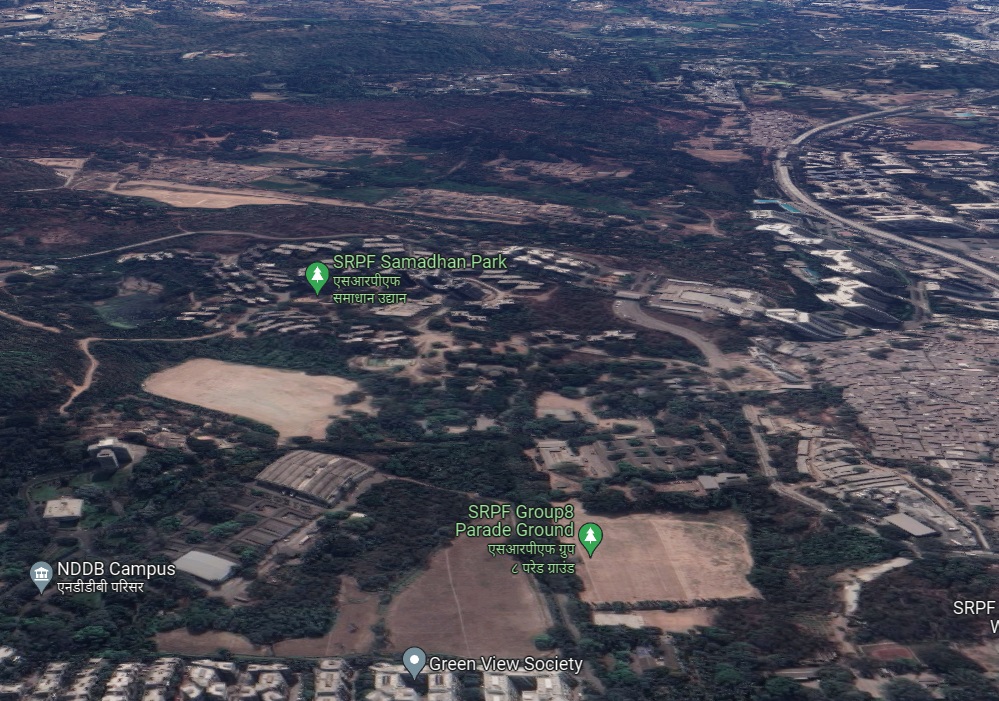
And this is what is look from the other side today..
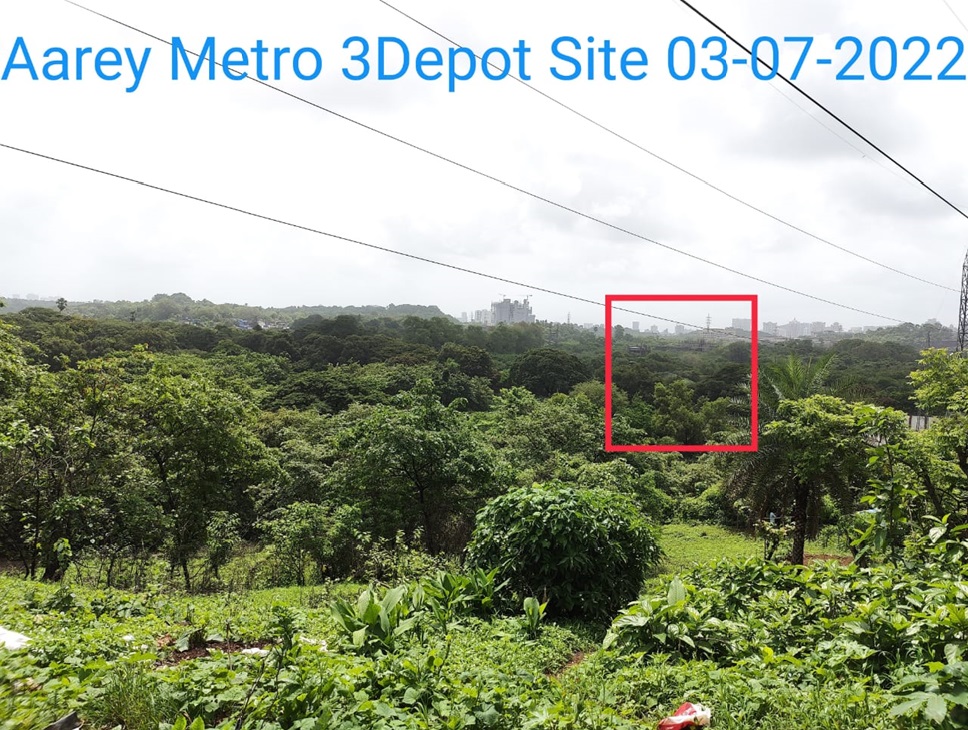
(Pix-Aarey Conservation Group )
Where is the Laxman Rekha? Can we draw one now?
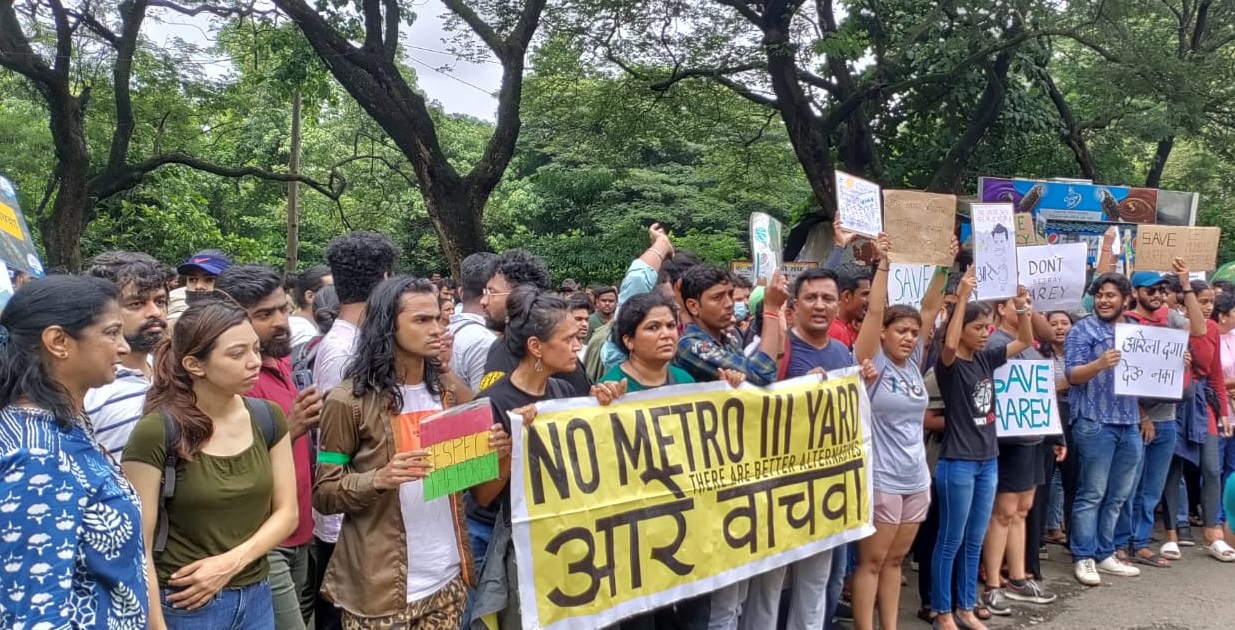
- Esther Duflo
- Google Is Not What It Seems by Julian Assange
- Anonymous Complainant Targeting Zubair Tweet Linked to Tek Fog App, BJYM Leader in Gujarat
- Salute Association for Democratic Rights (APDR) on turning 50
- Sado-Monetarism
- Agnipath: One more disaster in the making
- Agnipath: Path of Militarisation of Society?
- ‘Paid news’ and ‘paid social media’ in India: looking for legal attention
- The threat of large-scale famine
- Post COVID 2nd Wave impact on Vulnerable Communities: Household Survey Anna Adhikar Abiyan
- Human Future in the Digital Era – Whence society? Whence humanity ?
- Need a whistle blower protection law
- Government speak on Sedition
- Covid-19: When will the profiteering of private hospitals be curbed?
- Why we need feminist leadership for climate justice
- Hasdeo Forests & Adani
- Ahimsa Conversations over two years
- Where are we heading?
- Prema Gopalan: A Tribute
- Supporters of the Three Farm Laws? Statistics ?
Page 8 of 16
